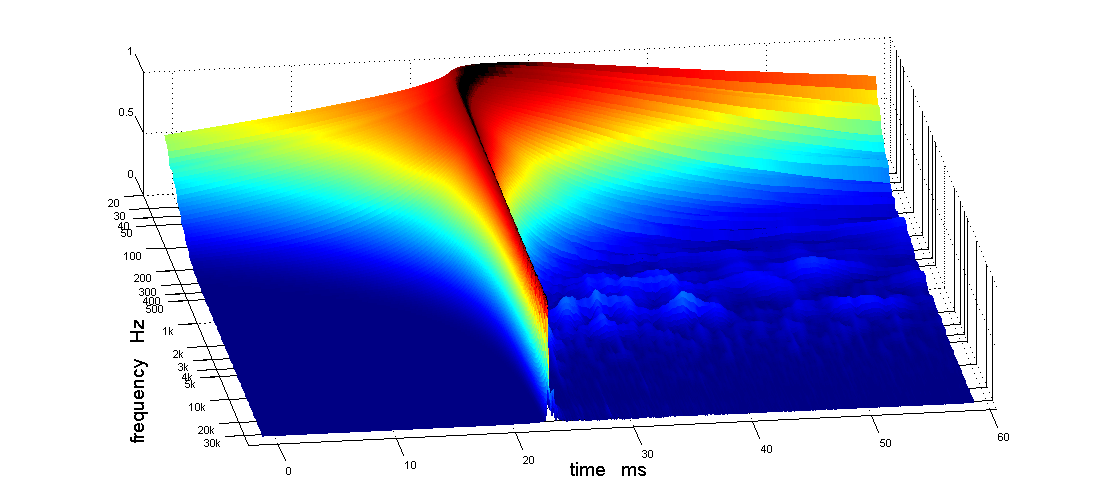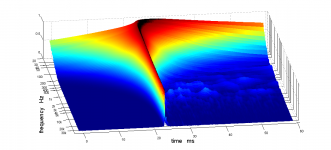But that's one of the main points of this thread!
I appreciate that you accept this uncertainty, still I can't believe that that's the best one can hope for.
Look sax512 and wesayso it must be possible if we brainstorm this subject together to find out where our microphone really sits down there at LF, haven't got time right now to look into it but think about we can set up a woofer in a sealed enclosure and via its impedance tune enclosure to a know roll off and if we stick microphone within few millimeters of cone we can measure pretty precise that roll off and see where phase deviation sits compared to the known roll off, upon this we also in REW have possibility to band pass IR via "Filtered IR" tab and shouldn't some of these stuff have possibility to get us wiser into subject.
I agree with you here BYRTT, but my personal battle has been with speaker/room integration as my actual room influences my perceived result much more than getting that last bit of phase rotation right. Especially at low frequencies.
I'm not out or after creating the best speaker, I try to create the best speaker/room interaction. As even a perfect speaker would very likely sound very different in my room than in an anechoic environment. I live in that room, so that's where I want to have the best sound possible. I doubt the deviation of phase of a microphone compared to text book phase behaviour influences the sound more than my room does. 😉
I'm not out or after creating the best speaker, I try to create the best speaker/room interaction. As even a perfect speaker would very likely sound very different in my room than in an anechoic environment. I live in that room, so that's where I want to have the best sound possible. I doubt the deviation of phase of a microphone compared to text book phase behaviour influences the sound more than my room does. 😉
we can set up a woofer in a sealed enclosure and via its impedance tune enclosure to a know roll off and if we stick microphone within few millimeters of cone we can measure pretty precise that roll off and see where phase deviation sits compared to the known roll off
I might not quite understand the process you are describing here. Isn't this pretty much the same as calculating phase from frequency response through the Hilbert inverse transform, under the assumption that the microphone is a minimum phase device?
Basically using the same procedure for low frequencies that many use for mid-high frequencies?
It's possible to measure the frequency response of a mike to very low frequencies with a pistonphone. If there are no filters the response should show the phase response. There will be a phase shift as the high pass effect from several mechinsims take over. The system is not DC coupled.
You could use a pressure transducer for lf and there won't be phase issues. There are some mems ones that would work.
In a room where the dimensions are similar to the wavelengths of sound you will probably get a really messy curve. The resonances will be dominant making phase almost meaningless.
What works for me is a few notch filters tuned to the resonant frequency of the room. Q of 5 or more. Depth of 40 dB. You cannot tune by ear with music. Easy with a simple tuneable oscillator and a sound meter. You will hear the difference but not the notches.
Sent from my LG-H811 using Tapatalk
You could use a pressure transducer for lf and there won't be phase issues. There are some mems ones that would work.
In a room where the dimensions are similar to the wavelengths of sound you will probably get a really messy curve. The resonances will be dominant making phase almost meaningless.
What works for me is a few notch filters tuned to the resonant frequency of the room. Q of 5 or more. Depth of 40 dB. You cannot tune by ear with music. Easy with a simple tuneable oscillator and a sound meter. You will hear the difference but not the notches.
Sent from my LG-H811 using Tapatalk
I might not quite understand the process you are describing here. Isn't this pretty much the same as calculating phase from frequency response through the Hilbert inverse transform, under the assumption that the microphone is a minimum phase device?
Basically using the same procedure for low frequencies that many use for mid-high frequencies?
First thing last December did visit home of wesayso and agree his findings so far because of actual high subjective/objective system performance so is also little layed back about this subject but also curious.
This proposal was about a LF corner reference and lets say we can make that to be BW2 at 62,2Hz or whatever and maybe also use some multiple IR filters to quality check response after near field sweep think you should be able to calibrate your mic LF curve corner from that or get some hints.
Probably from Rephase thread in past had two papers into subject see below.
Attachments
And by the way wesayso's nice curves using APL_TDA a page back reminds me can and will ask member and creator Raimonds if he knows about subject and will offer help, say this because his software don't offer and use corrections files at all but think understand has its own probably very unik multiple time domain filtering that this way know where DC exactly sits 😀 because it can show high resolution timing settings for phase and group delay.
When speaking this software can't resist show work from other night using Raimonds auto EQ to form two pass bands that are within 1/8 wave lenght for SPH-250KE and 10F/8424 because is bit impressed myself and REW confirm the nice data showing me cleanest waterfall ever had, maybe at first it looks even better but this is mono speaker at 90 cm distance with mic middle way between drivers and wesayso's is superior to this in its both channels and at listening position.

When speaking this software can't resist show work from other night using Raimonds auto EQ to form two pass bands that are within 1/8 wave lenght for SPH-250KE and 10F/8424 because is bit impressed myself and REW confirm the nice data showing me cleanest waterfall ever had, maybe at first it looks even better but this is mono speaker at 90 cm distance with mic middle way between drivers and wesayso's is superior to this in its both channels and at listening position.
Attachments
- Status
- Not open for further replies.
